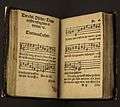Christe, du Lamm Gottes
| "Christe, du Lamm Gottes" | |
|---|---|
| Hymn by Martin Luther | |
 An image of Christ as the Lamb of God ("Lamm Gottes"), addressed in the hymn | |
| English | Christ, you Lamb of God |
| Text | translation |
| Language | German |
| Based on | "Agnus Dei" |
| Published | 1528 |
"Christe, du Lamm Gottes" (Christ, you Lamb of God) is a Lutheran hymn, often referred to as the German Agnus Dei. Martin Luther derived the words as a translation of the Latin Agnus Dei from the liturgy of the mass, and the tune from an older model. The hymn was first published in 1528. It has been the basis for several musical settings by composers such as Bach, Mendelssohn and Hessenberg. It appears in the current German hymnals, both the Protestant Evangelisches Gesangbuch (EG 190:2) and the Catholic Gotteslob (GL 208).
History and words
When Luther introduced the Reformation, he tried to keep much of the order of the mass, but in German.[1] He published in 1526 Deutsche Messe, an alternative liturgy for a Gottesdienst (church service) in German, which was first sung in Advent of 1525. It did not contain the liturgical parts Credo and Agnus Dei as translations from the Latin, but different German hymns instead.[2] The translation of the Agnus Dei would instead be sung during communion, alternatively "Jesus Christus, unser Heiland", which eventually was preferred as teaching more.[2]
The hymn appeared with the tune first in Bugenhagen's Braunschweig order of church service, printed in Wittenberg in 1528.[3][4] The number in the current Protestant hymnal Evangelisches Gesangbuch (EG) is 190:2.[5] In the current Gotteslob, it appears as GL 208, with a slightly different melody.[6]
Tune and settings
The scholar Robin A. Leaver points out that Luther used in his Deutsche Messe the tune of the Kyrie also to the German Agnus Dei, achieving symmetry.[2] It is Gregorian chant in the first mode (Dorian).[3] Leaver notes that the melody was not printed with the hymn until 1528, but that it was implied already in the Deutsche Messe.[2]

The hymn is featured, often in elaborate settings, by composers through the centuries. Bach used it several times, notably in a complex setting, which he first used in the lost Weimarer Passion, then in his cantata for the last Sunday before Lent Du wahrer Gott und Davids Sohn, BWV 23, then in the second version of his St John Passion.[7] Bach composed a chorale prelude (as a canon at the twelfth interval) (BWV 619) as part of his Orgelbüchlein.
Felix Mendelssohn composed a chorale cantata for choir and orchestra.[8] Kurt Hessenberg composed a five-part motet, published in 1951.[9]
References
- ↑ Schulz, Frieder (2003). Evangelisches Gesangbuch 190:2. Liederkunde zum Evangelischen Gesangbuch (in German). Vandenhoeck & Ruprecht. pp. 102–103. ISBN 9783525503300. Retrieved 4 March 2016.
- 1 2 3 4 Leaver, Robin A. (2007). Luther's Liturgical Music. Wm. B. Eerdmans Publishing. pp. 185–187, 198–199, 231–103. ISBN 9780802832214. Retrieved 4 March 2016.
- 1 2 "Christe, du Lamm Gotte". hymnary.org. Retrieved 4 March 2016.
- ↑ "36. Christe, du Lamm Gotte" (PDF). Luther Gesellschaft. Retrieved 4 March 2016.
- ↑ "Evangelisches Gesangbuch 190:2" (in German). l4a.org. Retrieved 4 March 2016.
- ↑ "Gotteslobvideo (GL 208): Christe, du Lamm Gottes" (in German). www.katholisch.de. Retrieved 4 March 2016.
- ↑ Wolff, Christoph (1995). "From konzertmeister to thomaskantor: Bach's cantata production 1713 to 1723" (PDF). Bach-Cantatas. pp. 17–19. Retrieved 6 February 2016.
- ↑ "Felix Mendelssohn / Christe, du Lamm Gottes, chorale cantata for chorus & orchestra". AllMusic. Retrieved 4 March 2016.
- ↑ "Christe, du Lamm Gotte" (PDF). Schott. Retrieved 4 March 2016.
External links
 Media related to Christe, du Lamm Gottes at Wikimedia Commons
Media related to Christe, du Lamm Gottes at Wikimedia Commons
